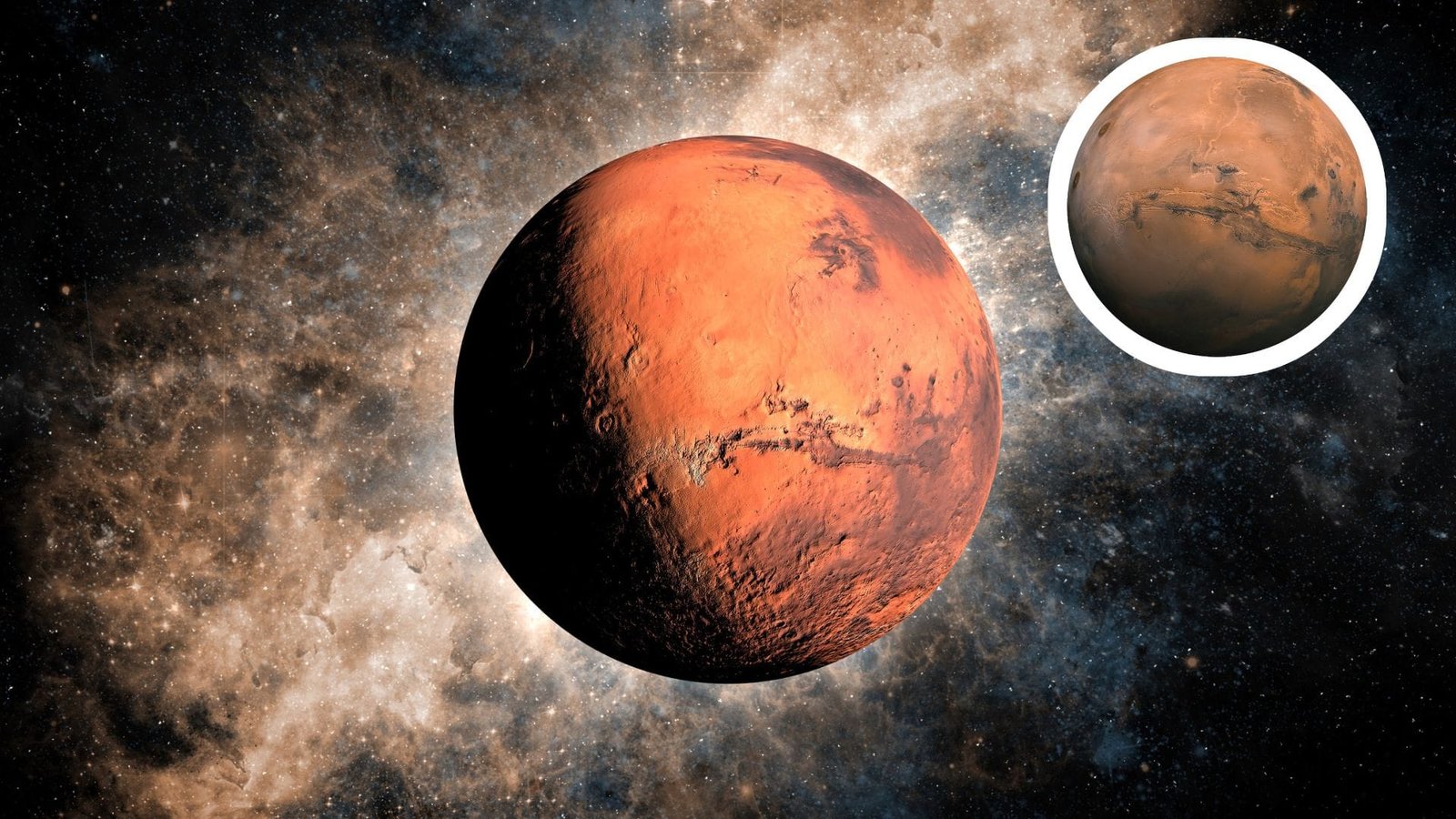

Introduction to Mars Exploration
Mars, often referred to as the Red Planet, has long captivated the imagination of scientists and enthusiasts alike. As the fourth planet from the Sun, it occupies a unique position in our solar system, being one of the most studied celestial bodies aside from Earth. The allure of Mars stems not only from its striking reddish hue, caused by iron oxide on its surface, but also from its potential to harbor past or even present life, making it a prime target for exploration.
The history of Mars exploration dates back to the early 20th century when astronomers began to discern features on its surface through telescopic observations. The 1960s marked a significant turning point with the advent of space missions aimed explicitly at the Martian surface. The Mariner missions initially provided close-up photographs and data that sparked further interest, leading to ambitious missions such as Viking 1 and Viking 2 in the 1970s. These landmark missions not only returned valuable data but also set the stage for future exploration by revealing the planet’s complex geology and thin atmosphere.
The reasons scientists are drawn to Mars are manifold. Primarily, researchers are keen to understand whether Mars could have hosted life in its ancient past, given the existence of water in various forms on its surface. Additionally, the differences and similarities between Earth and Mars offer valuable insights into planetary evolution and conditions conducive to life. Recent technological advancements have significantly enhanced our ability to explore this enigmatic planet. High-resolution imagery, precision landing systems, and advanced robotic spacecraft have made it possible to conduct intricate studies of Martian terrain and climate.
As we continue to unravel the mysteries of Mars, each mission presents an opportunity to deepen our understanding of not only our celestial neighbor but also the broader implications for life beyond Earth.
The Robotics Revolution: Mars Rovers and Landers
The exploration of Mars has been significantly advanced by various robotic vehicles, which include both rovers and landers. These machines are equipped with sophisticated technology enabling them to perform scientific experiments and relay valuable data back to Earth. Each mission contributes uniquely to our understanding of the Martian environment, geology, and potential for life.
One of the most iconic rovers is the Mars Curiosity Rover, which landed on the Martian surface in August 2012. Curiosity was designed to investigate whether Mars ever had the environmental conditions to support microbial life. It is equipped with a suite of advanced scientific tools that allow it to analyze soil samples, study the planet’s climate, and explore its diverse terrain. Over its mission duration, Curiosity has gathered a wealth of information about ancient Martian water sources and organic molecules, enhancing our understanding of the planet’s past.
Another significant addition to Mars exploration is the Perseverance Rover, which successfully landed on the planet in February 2021. This rover focuses on astrobiology and seeks to identify signs of ancient microbial life. In addition to its scientific objectives, Perseverance carries a technology demonstration called Ingenuity, which is the first helicopter to fly on another planet. Together, these innovations mark a new era of exploration, allowing for unprecedented aerial exploration of the Martian landscape.
Although the more recent missions like Curiosity and Perseverance receive considerable attention, earlier missions such as the Viking program of the 1970s laid the groundwork for future robotic exploration. The Viking landers provided the first detailed images and data from the surface of Mars, assessing atmospheric composition and searching for signs of life. These pioneering missions have paved the way for current and future endeavors on Mars, significantly enriching our understanding of the Red Planet.
Scientific Instruments on Board
The exploration of Mars has been significantly enhanced by the deployment of advanced scientific instruments on various rovers and landers. These sophisticated tools are designed to operate in the harsh conditions of the Martian environment, facilitating a wide array of scientific investigations. One of the primary objectives of these instruments is to analyze soil samples collected from the Martian surface. For instance, the Alpha Particle X-ray Spectrometer (APXS) evaluates elemental compositions of Martian rocks and soil, providing critical insights into the planet’s geological history.
In addition to examining soil, several instruments are dedicated to atmospheric studies. The Mastcam and ChemCam onboard the Curiosity rover, for example, capture high-resolution images and analyze the composition of the Martian atmosphere. These tools provide essential data regarding weather patterns, seasonal changes, and atmospheric composition, which are crucial for understanding Mars’ climate and potential habitability. Furthermore, instrument packages like the Mars Climate Sounder on the Mars Reconnaissance Orbiter allow scientists to monitor temperature and humidity variations, enhancing our knowledge of Martian meteorology.
Moreover, a key focus of these instruments is the search for signs of past life, or biosignatures. The Sample Analysis at Mars (SAM) instrument suite is particularly noteworthy as it conducts in-depth chemical analyses of soil and rock samples to identify organic compounds. This endeavor aims to ascertain whether Mars could have once supported microbial life, a question that has profound implications for our understanding of life beyond Earth. However, operating in the Martian environment presents unique challenges, such as extreme temperatures and dust storms, which can affect instrument performance. Scientists and engineers continuously innovate to mitigate these challenges, ensuring that these scientific instruments effectively gather and transmit valuable data from the red planet.
Notable Discoveries on Mars
The exploration of Mars has been significantly advanced by various robotic missions, providing crucial insights into the planet’s environment and history. Among the most pivotal discoveries is evidence of water, which has major implications for our understanding of the Red Planet. Observations from orbiters and rovers have revealed signs of ancient riverbeds, polar ice caps, and salty liquid water brines, suggesting that Mars once had a much warmer and wetter climate compared to its current state.
Geological studies conducted by rovers such as Curiosity and Perseverance have unveiled a diverse landscape marked by volcanic rocks, sedimentary structures, and unique mineral signatures. These geological formations indicate a complex history of volcanic activity and erosion processes that have shaped the surface over billions of years. This information not only provides clues about Mars’ past but also enhances our understanding of planetary evolution in general.
The study of Mars’ climate is another focal point of robotic discoveries. Data collected from Martian atmospheric sensors has allowed scientists to evaluate climate patterns and seasonal changes. This has led to revelations about dust storms, temperature fluctuations, and atmospheric composition. Such findings are critical, providing a comprehensive view of how Mars has transitioned over time and the factors influencing its current inhospitable conditions.
Perhaps most significantly, these explorations have raised important questions regarding the potential habitability of Mars. The identification of water, alongside organic molecules detected by the Curiosity rover, fuels interest in the possibility of microbial life existing or having existed on the planet. This paradigm shift in our understanding of Mars not only opens up exciting avenues for additional research but also illustrates the ongoing quest to uncover the mysteries of our neighboring planet.
Mars Missions: A Timeline
The exploration of Mars has a rich history characterized by various missions aimed at understanding the planet’s environment, geology, and potential for life. The timeline of significant Mars missions spans several decades, beginning with the initial flybys in the 1960s, which offered the first glimpses of the planet’s surface. One of the earliest successful missions was NASA’s Mariner 4, launched in 1964, which conducted a flyby of Mars in 1965, sending back the first photographs that indicated a cratered landscape.
Following Mariner 4, the Viking program in the mid-1970s marked a notable progression in Mars exploration. Viking 1 and Viking 2 were launched in 1975, and they successfully landed on the Martian surface, providing extensive data on the planet’s atmosphere and surface conditions. These missions captured the public’s imagination and set the foundation for future exploration.
The 1990s witnessed the Mars Observer mission, though it experienced an unfortunate end when communication was lost shortly before entering orbit around Mars. However, the subsequent Mars Global Surveyor, launched in 1996, successfully mapped the Martian surface, revealing evidence of past water activity and setting the stage for more in-depth research.
In the early 2000s, the Spirit and Opportunity rovers, part of NASA’s Mars Exploration Rover program, enhanced our understanding of the planet with their extensive in-situ analyses, discovering evidence of past liquid water. Following their success, the Curiosity rover, landed in 2012, continued this trend, equipped with advanced instruments to search for signs of habitability.
The most recent missions, such as the Perseverance rover, which landed in February 2021, and the Ingenuity helicopter, have expanded our exploration capabilities further. These missions not only investigate past habitability but also focus on preparing for future human exploration of Mars. Each of these milestones reflects our expanding knowledge and commitment to understanding the Red Planet, illustrating the evolution of robotic residents on Mars and human ingenuity in space exploration.
International Collaboration in Mars Exploration
The exploration of Mars has become a focal point for numerous space agencies around the world, including NASA, the European Space Agency (ESA), the China National Space Administration (CNSA), and the Indian Space Research Organisation (ISRO). These organizations have recognized that collaborative efforts not only drive advancements in technology but also enhance our collective understanding of the red planet. By pooling resources and expertise, international partnerships have significantly contributed to a wealth of knowledge about Mars.
Joint missions have played a crucial role in fostering collaboration among these agencies. One notable example is the Mars Sample Return mission, which is a collaborative effort involving NASA and ESA. This ambitious initiative aims to collect samples from the Martian surface and return them to Earth, marking a pivotal advancement in planetary science. Such missions underscore the importance of shared objectives in planetary exploration, bringing together different nations to strive towards a common goal of understanding Mars’ geology and potential for life.
Moreover, shared technologies have frequently emerged from international collaborations. For instance, scientific instruments and engineering solutions from various agencies have been combined to enhance the capabilities of rovers and orbiters exploring Mars. The Mars Perseverance rover, developed by NASA, utilizes components that were co-engineered with international partners, demonstrating how technology sharing can lead to more robust missions.
In addition to hardware, knowledge exchange among scientists and researchers has cultivated a richer dataset concerning Mars. Conferences and joint studies allow for the dissemination of findings, enabling a comprehensive view of the red planet’s nature. These collaborative efforts ultimately strive to answer fundamental questions about Mars’ history and the possibilities of future human exploration. Therefore, international cooperation in Mars exploration not only maximizes research output but also embodies humanity’s united quest to unveil the mysteries of the red planet.
Future Missions and What Lies Ahead
The exploration of Mars has garnered significant interest from space agencies and private organizations alike, leading to a multitude of upcoming missions that aim to enhance our understanding of the Red Planet. One of the most noteworthy planned missions is the crewed missions, which aim to establish a human presence on Mars. NASA’s Artemis program plans to return humans to the Moon as a stepping stone for future Mars exploration, developing technologies that would be critical for long-duration space travel and habitation on the Martian surface.
In addition to crewed missions, various robotic endeavors are also being designed to further our exploration of Mars. Notably, NASA’s Perseverance rover, which landed in early 2021, will serve as a precursor to crewed missions by performing sample collection and analysis, testing new technologies, and assessing the planet’s habitability. The rover’s technology includes advanced imaging systems and surface analysis tools that can assess the Martian environment for future colonizers.
Internationally, agencies such as the European Space Agency (ESA) and Roscosmos are collaborating on the ExoMars program, which plans to send the Rosalind Franklin rover to search for signs of past life. This mission will utilize advanced instrumentation to analyze Martian soil and atmosphere, providing critical data to inform future human exploration.
Private companies like SpaceX are also targeting Mars, with their Starship vehicle aimed at transporting humans and cargo to the Martian surface. The development of this fully reusable spacecraft highlights the merge of governmental and commercial efforts in reducing the costs and complexities associated with Mars missions.
Overall, the continued technological advancements and collaborative efforts in space exploration are robust indicators of humanity’s commitment to understanding Mars. These future missions, blending both human and robotic exploration, promise to unlock the mysteries of the Red Planet and could lay the groundwork for establishing a sustainable presence on Mars in the decades to come.
The Challenges of Robotic Exploration on Mars
The exploration of Mars, often referred to as the Red Planet, has become a focal point for scientific inquiry. Robotic missions, which have been essential to our understanding of Martian geology, climate, and potential for life, face numerous challenges. The harsh environmental conditions on Mars, characterized by extreme temperatures, dust storms, and high radiation levels, significantly complicate the design and operation of robotic spacecraft.
For instance, temperatures on Mars can drop to as low as -195 degrees Fahrenheit (-125 degrees Celsius) during winter at the poles, while the equatorial regions can reach up to 70 degrees Fahrenheit (20 degrees Celsius) during the day. This drastic temperature fluctuation creates challenges for the integrity of materials and instruments, necessitating innovative engineering solutions. Spacecraft must be equipped with robust thermal protection systems to ensure their longevity and functionality throughout their missions.
Another critical challenge is the communication delay between Earth and Mars, which can range from 4 to 24 minutes one way, depending on the relative positions of the planets. This delay complicates real-time control and monitoring, requiring automated systems to perform tasks independently. To mitigate this issue, mission teams have developed advanced algorithms that allow rovers to make autonomous decisions while navigating the Martian terrain.
Furthermore, technical malfunctions are an inherent risk in robotic exploration. Spacecraft must be designed to withstand Martian dust, which can interfere with solar panels and instrumentation. To combat these issues, engineers have designed systems that can self-diagnose and self-correct to some extent, reducing the need for constant oversight from mission control.
Overall, the exploration of Mars is marked by a host of challenges that test the limits of our engineering capabilities. Nonetheless, each mission contributes valuable insights and innovations, pushing the boundaries of what robotic technology can achieve in space exploration.
Public Interest and Impact of Mars Exploration
The exploration of Mars has significantly captured the public’s attention, a phenomenon largely fueled by the media coverage surrounding various missions. News outlets dedicate considerable space to updates on missions such as NASA’s Perseverance rover or SpaceX’s ambitious plans to program human missions to the Red Planet. This extensive media attention plays a critical role in fostering a broader public engagement with space exploration. As images and findings from Mars are disseminated across platforms, interest surges, illustrating how connectivity and technology can bridge the gap between scientific communities and the general populace.
Moreover, educational initiatives inspired by Mars exploration contribute substantially to public engagement. Schools and universities have begun to integrate Mars-related curricula and projects, enabling students to learn about planetary science, engineering, and robotics through the lens of current exploration efforts. Programs such as robotic competitions and STEM outreach initiatives encourage young learners to pursue careers in sciences and engineering, effectively cultivating future generations of scientists and explorers. These educational frameworks not only elevate awareness about Mars but also instill a sense of wonder and possibility.
The impact of Mars exploration transcends scientific advancements; it significantly influences culture and society. Concepts from Mars missions permeate popular culture, illustrating how tales of space travel can resonate with themes of exploration and the human spirit. Science fiction literature and films frequently draw upon the mystery and allure of Mars, reflecting and amplifying public curiosity. By framing Mars exploration as a shared human endeavor, society connects emotionally to the journey, inspiring a collective aspiration for discovery and understanding. The drive to explore the Red Planet blends scientific inquiry with human narrative, reinforcing how exploration of Mars offers not just knowledge, but also hope for humanity’s future.






